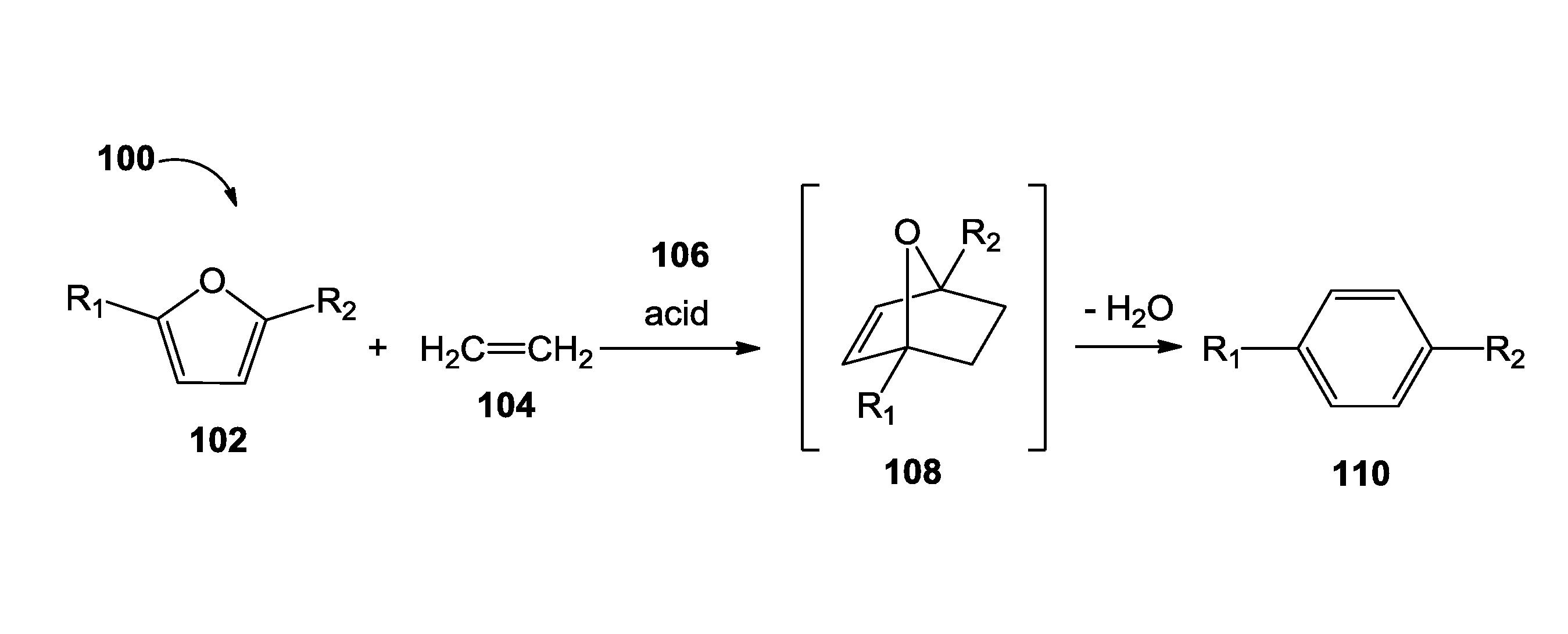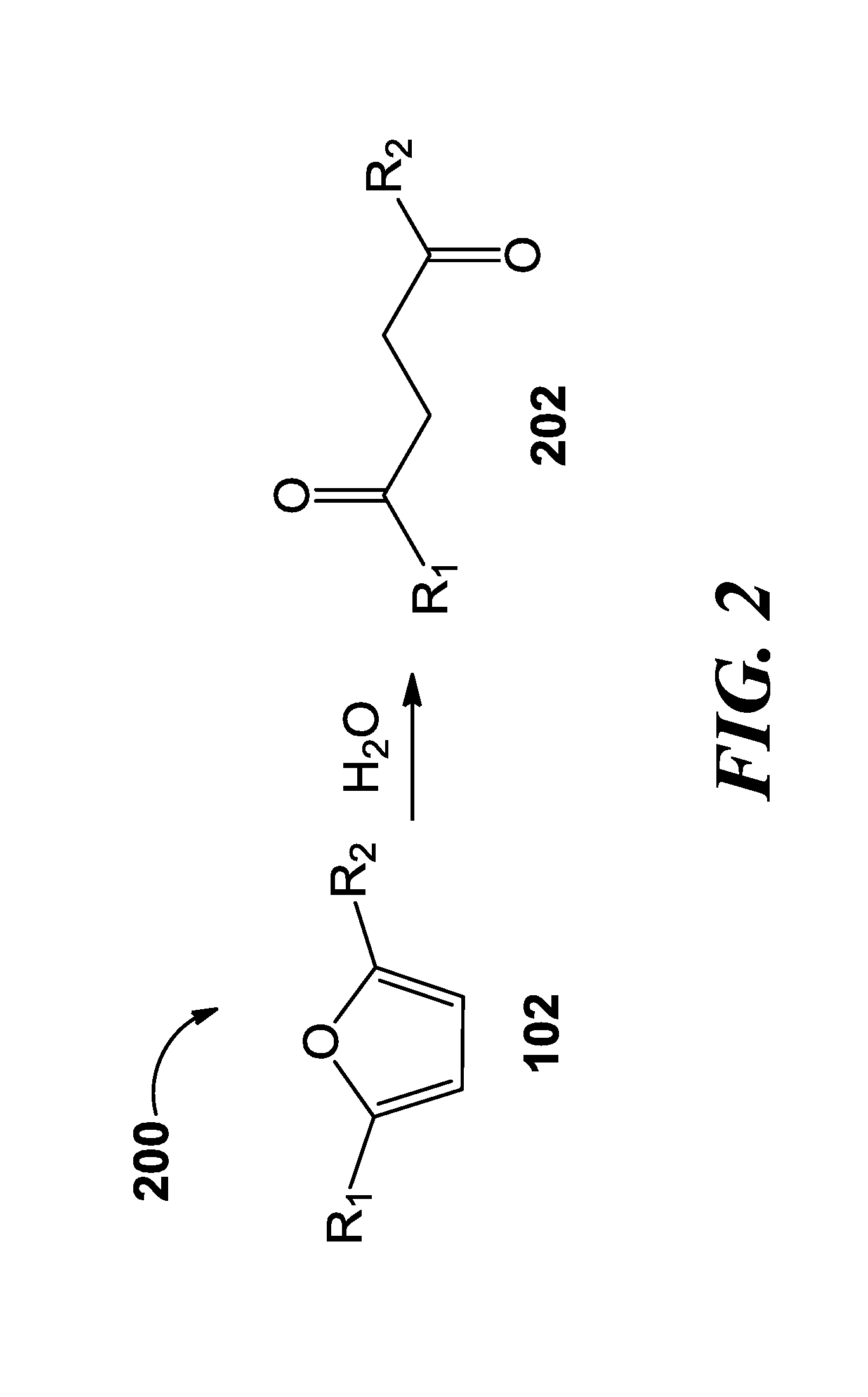Methods of producing para-xylene and terephthalic acid
a technology of terephthalic acid and paraxylene, which is applied in the preparation of carboxylic compounds, hydrocarbon preparation catalysts, organic chemistry, etc., can solve the problems of perpetuating reliance, generating greenhouse gas emissions, and commercial conditions that are not practicable, and achieves the effect of higher yield
- Summary
- Abstract
- Description
- Claims
- Application Information
AI Technical Summary
Benefits of technology
Problems solved by technology
Method used
Image
Examples
example 1
Preparation of Para-Xylene from DMF
[0150]
[0151]This example demonstrates the conversion of DMF into para-xylene. Dimethylfuran (DMF, 0.25 mL), and acetic anhydride (0.010 mL) were added to a hastelloy reactor (1 L) under an argon atmosphere. An inert compound, such as tetradecane (0.25 mL), was added to the reaction only to serve as an internal standard to quantify the product produced. The reactor was sealed and charged with ethylene gas (50 barg). The reactor was heated (175° C.) and mechanically stirred for 15 hours. The reactor was cooled to room temperature, and vented into a trap containing dichloromethane (DCM, 250 mL). Dichloromethane (100 mL) was used to extract the remaining organics from the reactor.
[0152]An aliquot was taken from the DCM trap and from the DCM extraction solution, and analyzed by gas chromatography mass spectrum (GCMS). The following GCMS protocol was used. Initial oven temp: 45° C. for 3 minutes then 15° C. / min to 220° C. (14.67 min run time); inlet temp...
example 2
Effect of Temperature on Synthesis of Para-Xylene from DMF
[0153]This example demonstrates the impact of temperature on the synthesis of para-xylene from DMF. Three different catalysts were tested, including AlCl3, Cu(OTf)2 and CuCl2, at various temperature between 150° C. and 220° C.
[0154]For each catalyst and temperature set forth in Table 1 below, the following general procedure was used: 2,5-dimethylfuran (10 g, 0.10 mole), 1,4-dioxane (200 g), 4 Å sieves (2 g), and the catalyst set forth in Table 1 below (1 g) were added into a hastelloy autoclave reactor, which was equipped with a gas impeller. The contents in the reactor were stirred at room temperature. The reactor was charged with ethylene gas until the pressure stabilized to 450 psig. The reactor was heated to the temperature as set forth in Table 1 below, and allowed to react for 24 hours. The reactor was then cooled and depressurized. A sample was taken from the reactor, and the sample was analyzed by 1H-NMR.
[0155]
TABLE 1...
example 3
Effect of Catalyst on Synthesis of Para-Xylene from DMF
[0156]This example demonstrates the impact of the catalyst on the synthesis of para-xylene from DMF. Various different Lewis acid were tested.
[0157]For each catalyst, temperature, reaction time and pressure of ethylene added set forth in Table 2 below, the following general procedure was used, unless as otherwise noted in Table 2: 2,5-dimethylfuran (10 g, 0.10 mole), 1,4-dioxane (200 g), 4 Å sieves (2 g), and catalyst (1 g) was added into a hastelloy autoclave reactor and was stirred at room temperature. The reactor was charged with ethylene gas until the pressure stabilized to the pressure set forth in Table 2 below. The reactor was heated to the temperature set forth in Table 2 below, and allowed to react for 24 hours. The reactor was then cooled and depressurized. A sample was taken from the reactor, and the sample was analyzed by 1H-NMR or GC-FID.
[0158]
TABLE 2Effect of catalyst on the synthesis of para-Xylene from DMFReactio...
PUM
| Property | Measurement | Unit |
|---|---|---|
| temperature | aaaaa | aaaaa |
| temperature | aaaaa | aaaaa |
| temperature | aaaaa | aaaaa |
Abstract
Description
Claims
Application Information
 Login to View More
Login to View More - R&D
- Intellectual Property
- Life Sciences
- Materials
- Tech Scout
- Unparalleled Data Quality
- Higher Quality Content
- 60% Fewer Hallucinations
Browse by: Latest US Patents, China's latest patents, Technical Efficacy Thesaurus, Application Domain, Technology Topic, Popular Technical Reports.
© 2025 PatSnap. All rights reserved.Legal|Privacy policy|Modern Slavery Act Transparency Statement|Sitemap|About US| Contact US: help@patsnap.com



